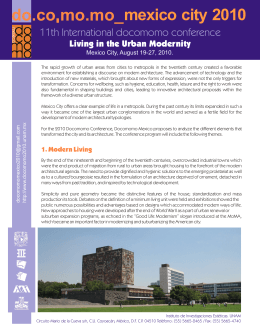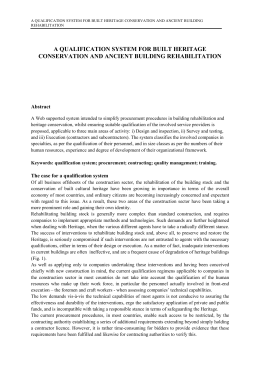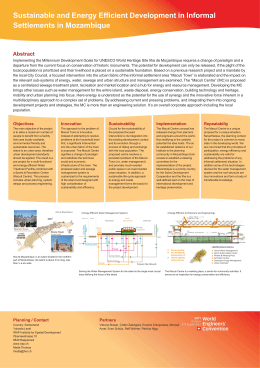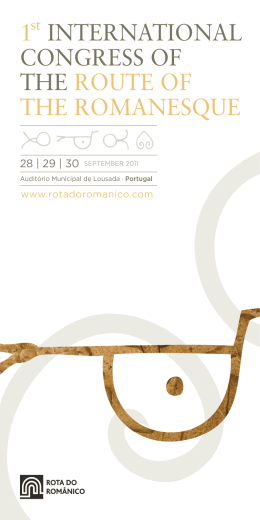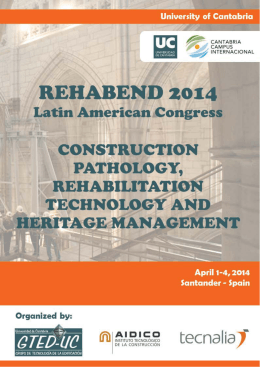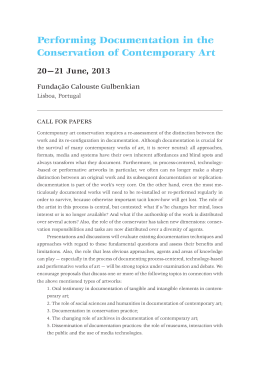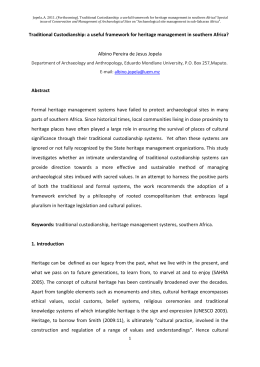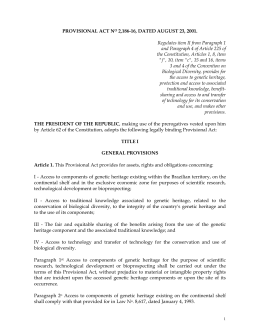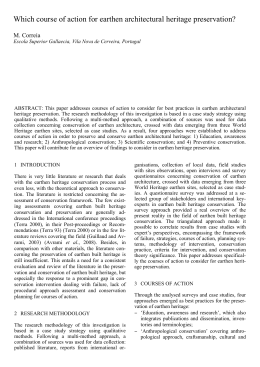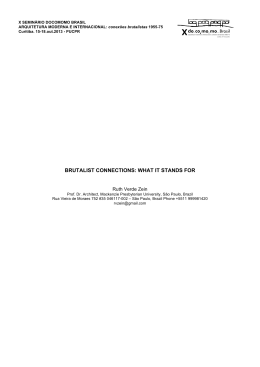COUNCIL OF EUROPE COMMITTEE OF MINISTERS RECOMMENDATION No. R (91) 13 OF THE COMMITTEE OF MINISTERS TO MEMBER STATES ON THE PROTECTION OF THE TWENTIETH-CENTURY ARCHITECTURAL HERITAGE1 (Adopted by the Committee of Ministers on 9 September 1991 at the 461st meeting of the Ministers' Deputies) The Committee of Ministers, under the terms of Article 15.b of the Statute of the Council of Europe, Considering that the aim of the Council of Europe is to achieve a greater unity between its members; Having regard to the European Cultural Convention signed in Paris on 19 December 1954, and Article 1 thereof in particular; Having regard to the Convention for the Protection of the Architectural Heritage of Europe signed in Granada on 3 October 1985, and Article 17 thereof in particular; Having regard to Resolution 813 (1983) of the Parliamentary Assembly of the Council of Europe on contemporary architecture; Having regard to Resolution No. 2 of the 2nd European Conference of Ministers responsible for the Architectural Heritage held in Granada on 3 and 4 October 1985; Observing that twentieth-century architecture is an integral part of Europe's historical heritage and that the preservation and enhancement of its most significant elements serve the same aims and principles as those of the conservation of the architectural heritage as a whole; Noting that because this section of the heritage is recent, abundant in examples, wide-ranging and diverse in character, it is less well recognized by official organisations and by the public than other parts of the architectural heritage; Emphasising that a lack of a specific interest in conserving this heritage would lead to irreparable losses and deprive future generations of this period of European consciousness, Recommends that the governments of the member states develop strategies for the identification, study, protection, conservation, restoration and public awareness of twentieth-century architecture with reference to the principles set out in the appendix to this recommendation, as part of their general policy for conserving the built heritage and, where necessary, by means of specific measures. Instructs the Secretary General to transmit the text of the present recommendation to non-member states party to the European Cultural Convention and/or the Convention for the Protection of the Architectural Heritage of Europe. 1. When this recommendation was adopted, the Representative of Germany, in application of Article 10.2.c of the Rules of Procedure for the meetings of the Ministers' Deputies, reserved the right of his government to comply with it or not. 1 Appendix to Recommendation No. R (91) 13 Principles for the conservation and enhancement of the architectural heritage of the twentieth century I. Identification of the twentieth-century heritage 1. Promoting knowledge and study of the heritage Since the end of the nineteenth century, architecture and urban planning have undergone profound changes due to industrialisation, the introduction of new materials, the transformation of construction techniques and new uses. This trend has gathered pace, at the same time as technological progress, in order to meet the needs of contemporary society. Buildings of the twentieth century are many in number and of varying character: they reflect both traditional and modernist values. With the exception of the work of certain pioneers, the buildings produced in the twentieth century are not recognised as having heritage value. It is therefore necessary to encourage better knowledge and understanding of this part of the heritage by drawing attention to its qualities and the wealth and diversity of its different forms. The research required for such a fuller understanding should take into account the whole conspectus of available sources, whether in the form of original graphic or photographic material, of information published at the time of the works in question, or of any other type of information which enables them to be considered in their appropriate context and on comprehensive understanding of buildings. 2. Making systematic inventories The aim here is to assemble systematic documentation on twentieth-century buildings either in the form of national lists covering all periods or by drawing up lists specific to twentieth-century architecture. These lists should be: - open-ended rather than selective, and amenable to continuous updating, revision and extension in the light of fresh information; - drawn up without prejudice as to style, type of building, method or period of construction; - designed, presented and published in such a manner that their content is available to the broadest possible public, in terms of vocabulary used, illustrations and arrangements for distribution; - compiled where possible so as to take account of survey practices in the different European countries, so as to promote mutual communication and understanding of these informative and analytical methods throughout Europe. II. Protection of the most significant heritage items 1. Criteria for selection The authorities responsible for protection should adopt specific criteria based on the following considerations: - the desirability of acknowledging the value of significant works taken from the whole range of styles, types and construction methods of the twentieth century; - the need to give protection not only to the works of the most famous designers in a given period or style of architecture, but also to less well-known examples which have significance for the architecture and history of the period; - the importance of including, among the selection factors, not only aesthetic aspects but the contribution made in terms of the history of technology and political, cultural, economic and social development; - the crucial importance of extending protection to every part of the built environment, including not only independent structures but also duplicated structures, planned estates, major ensembles and new towns, public spaces and amenities; - the need to extend protection to external and internal decorative features as well as to fittings and furnishings which are designed at the same time as the architecture and give meaning to the architect's creative work. 2. Practical measures for legal protection It is the task of the relevant authorities, in accordance with the procedures applicable in each country: 1. to make use of such legislation as already exists on conservation of the heritage, urban planning or the environment in respect of the architectural heritage of the twentieth century in order to: - protect buildings or artefacts by including them among lists of items to be protected or areas designated for conservation; 2 - make active use of the procedures for planning permission and control that are afforded by such measures of protection; 2. to supplement existing legislation by specific measures where this recent heritage is not protected, or is inadequately protected. III. Management and conservation of the heritage 1. Use of the heritage The relevant national, regional or local authorities have a duty to encourage the most appropriate use to be made of the protected heritage of this period, whether it be used for cultural or museum purposes or more generally for economic, commercial or residential purposes. Encouragement should be given to finding new uses which take account of the needs of present-day life so that buildings are not allowed to fall derelict, provided the new use does not run counter to the architectural or historical significance which was the reason for their protection. 2. Physical conservation Atmospheric pollution and the ageing of materials result in deterioration and require maintenance and restoration of the heritage, even when it is recent. It is important to: - promote scientific, theoretical and practical studies into methods of construction, maintenance and restoration of these structures and the various materials used in twentieth-century architecture and the corresponding decorative arts; - respect the same fundamental principles as are applied to other elements of the architectural heritage in planning programmes of maintenance and restoration of these structures; - create a full and careful record of observations made and action taken within the context of conservation; - set up at the appropriate national or regional level a system of information and architectural record, so that the history of buildings can be elicited and their future maintenance ensured. 3. Training of specialists It is important to improve and enhance the knowledge and use of appropriated building materials and technologies for construction and conservation. This will require the in-depth training of construction firms which carry out the physical work of conservation on site. The particular nature of twentieth-century architectural techniques entails specialisation on the part of the professionals whose task it is to study and preserve this heritage. The authorities of the member states should arrange for special training to be given, either as part of general architectural training or in the framework of specialist training courses in the restoration of the built heritage. The essential training should cover methods of study, investigative methods for this type of heritage and practical maintenance and restoration techniques. A special effort should be made in respect of specialised restoration techniques and crafts. Sufficient resources should be made available by the authorities for research and the training of experts. IV. Promotion of awareness among persons in positions of responsibility and among the public It is for the authorities of the member states to take a range of initiatives promoting awareness of the value and distinctive character of the various forms of twentieth-century architecture among elected representatives, building owners and users, professionals, the media and the public at large. This action will entail: 1. Encouraging programmes of education at every level both inside and outside schools, particularly as the majority of schools operate within a twentieth-century environment. This knowledge of a heritage which is close to the pupils should go hand in hand with discovery of the significance of architecture, urban planning and the environment; 2. Use of all available forms of media for campaigns of publicity, support for specialist publications, public debates or educational experiments in the broadest sense. V. The necessity for future European co-operation European co-operation is vital for the protection of the twentieth-century heritage because of the similarity and complexity of the construction techniques used, the problem of criteria for selection, and practical maintenance and conservation methods. For this purpose, member states are invited to: 1. encourage the regular exchange of experts, technical understanding and experience between educators, historians, architects, technicians and other professionals involved in protection and conservation; 3 2. develop mutual technical assistance, in particular by means of the machinery for technical assistance operated by the Council of Europe; 3. encourage increased understanding of the heritage and a co-ordination of effort at European level in order to solve problems concerning selection criteria and techniques of physical conservation; 4. promote policies to generate awareness of the twentieth-century heritage through publications and media campaigns under the auspices of the Council of Europe; 5. study the possibilities for multilateral conservation projects which could be set up at the European level for particularly important aspects of the twentieth-century heritage. 4 I 25.197
Download
